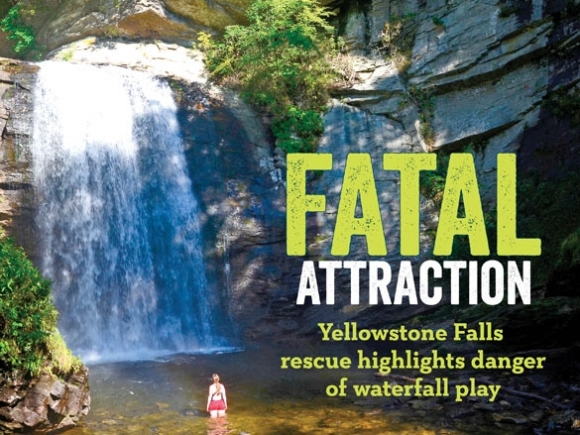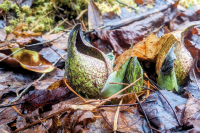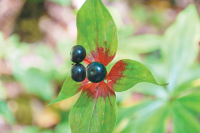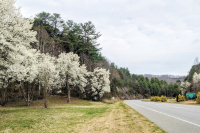Fatal Attraction: Herculean rescue effort at Yellowstone Falls highlights dangers of waterfall play

The 911 call, coming from a gorge cut high in the Balsam Mountains, was nearly unintelligible. When the connection ended five minutes later, Haywood County Emergency Management was left with two important facts: somebody had fallen from a waterfall, and the caller was saying something that sounded like “Yellowstone.”
SEE ALSO: WNC's deadliest waterfalls
The GPS coordinates showed the call originating in Dark Prong, two drainages over from Yellowstone Falls in the Pisgah National Forest’s Shining Rock Wilderness, but GPS data isn’t always correct in the rugged terrain of Western North Carolina. In the mountains, cell reception is often scant at best — emergency responders had to make a judgment call.
“We decided to go with Yellowstone, the word ‘Yellowstone,’ and sure enough that’s where they were,” said Haywood County Emergency Management Director Greg Shuping.
The call came in around 3:30 p.m. Wednesday, July 12, with rescue crews reaching the patient about an hour later. It would take four exhausting hours more to transport him to safety.
Yellowstone Falls, located between Skinny Dip Falls and the Lower Falls at Graveyard Fields, isn’t accessible by any official trail, and that’s on purpose.
Related Items
“It turns into a gorge from Lower Falls to Skinny Dip Falls,” said Joseph Massie, one of the 45 rescuers. “A lot of people don’t realize that. But it is dang near impossible to get down in there and even more difficult to get someone out.”
There’s a 300-foot drop in elevation from the bottom of the falls to the top of the ravine where the Mountains-to-Sea Trail passes by on the north side, and on the south side there’s no way out at all — especially for someone who’s no longer able to move. But with rainstorms coming through the area, a helicopter rescue was off the table. It would have to be a ground rescue.
 The patient, a man in his 50s whose name has not been released, had come to the falls with a few friends to climb around and enjoy the day. There’s a ledge that pops out about halfway up the 80-foot falls, which is where the man was climbing when he fell 40 feet to the rocky base. Miraculously, he survived the fall, but when he landed he couldn’t move. About five people saw it happen, immediately attempting a 911 call with the negligible signal making its way into the gorge.
The patient, a man in his 50s whose name has not been released, had come to the falls with a few friends to climb around and enjoy the day. There’s a ledge that pops out about halfway up the 80-foot falls, which is where the man was climbing when he fell 40 feet to the rocky base. Miraculously, he survived the fall, but when he landed he couldn’t move. About five people saw it happen, immediately attempting a 911 call with the negligible signal making its way into the gorge.
Four rescue crews from three counties totaling 68 people were required to extract that single, immobile patient from the gorge. Of those, 13 were part of the command center parked at the Graveyard Fields Trailhead, with the remaining 45 split into four different rescue teams. The rescuers came from Haywood County Search and Rescue, the Cruso Fire Department, the Henderson County Rescue Squad and the Transylvania County Rescue Squad.
Team one, which included rope riggers and paramedics, descended the gorge toward the patient, assessing his medical needs and then setting up a highline across the Yellowstone Prong, which eventually feeds into the Pigeon River. He’d landed on the south side of the river, but the only way out was to the north — rescuers hooked him up to the highline, rope rigged tight like a banjo string, to guarantee him a safe ride to the other side.
It’s a good thing they did, because just as the team had the patient ready for transport, the skinny stream of water coming over the falls transformed into a raging torrent, the result of an isolated rainstorm somewhere upstream — “an incident within an incident,” Shuping called it.
“The waterfall went from a clear, small waterfall to flooding a lot of the sides of the area where we were working and had the patient,” Massie said. “We had to swiftly get him moved to safety. It was nuts.”
From where Shuping sat, that river surge was a different kind of terrifying. It was an unforeseen and harrowing hazard for his team, but there wasn’t much he could do from his post at the command center, more than a mile away. The situation was perplexing, too. The river’s headwaters are probably less than a quarter mile upstream — how was such a dramatic swell even possible?
“How could a river with that small of a watershed flash that quickly to a point to cause us to be concerned?” Shuping said. “Well, it did. We learned that the hard way. Thank goodness nobody suffered because of it. That could have been catastrophic. We could have lost rescuers. We could have lost victims.”
Thankfully, amazingly, that’s not what happened. Team one reached the patient, and team two arrived with backup equipment to get everyone across the river. Then team three jumped in to rig ropes to haul everyone up the 300-foot ravine, with team four carrying the patient a mile out to the Graveyard Fields Trailhead. There, an ambulance was waiting to attend to his needs, and an airlift from the Mountain Area Medical Airlift soon arrived to whisk him to Mission Hospital in Asheville.
“This was a Super Bowl of rescues,” Shuping said. “For the wilderness setting, this was that hopefully once-in-a-decade type incident. But you know, we keep saying that, then they happen again.”
While Shuping said he couldn’t release the man’s name or the exact nature of his injuries, it’s safe to say the damage was substantial, and likely lasting. But without a skilled army of rescuers on the scene, the fall could have easily ended in death.
“The patient has injuries that they will not soon, if ever, overcome,” Shuping said. “But because of these rescuers, they’re alive — not only because of good luck or whatever. I know that we saved his life because there’s no other way this guy was coming out of that hole.”
A dangerous thrill
Shuping’s department doesn’t get a whole lot of calls for waterfall rescues, mostly because Haywood County’s status as a headwaters county means that there are few places where the volumes of water are big enough to create an acute danger.
But, as demonstrated by the surge that nearly devastated the rescue at Yellowstone Falls, river flows can be fickle. Currents can be stronger than anticipated, flow volumes can change within seconds, and rocks that appear dry and sturdy can prove dangerously loose and slippery.
“They had been playing on top of (the falls) prior to that,” Massie said of the group at Yellowstone Falls. “If they had been on top when that flash flood happened, there could have been six of them dead.”
It wouldn’t have been the first time someone had died on a WNC waterfall. Since 1993, at least 41 people have died on waterfalls in the Pisgah-Nantahala National Forest, and in the same timeframe an additional 31 have died in water-related falls and drownings in the Great Smoky Mountains National Park. Of those, 15 occurred at or near a waterfall.
That’s just a small subset of the total number of search and rescue calls the park gets annually to help one of the more than 10 million people who visit the park each year. Usually, the team responds to about 100 calls per year, most of which involve a milder sort of trip or fall and are resolved in a couple of hours. Waterfall trails do seem to have a disproportionately high number calls, said park spokeswoman Dana Soehn, but that’s likely because there’s a disproportionately high number of people who want to hike them.
“A lot of times you might have more inexperienced hikers,” she said of these trails. “They’re heading out for a short hike to a waterfall, they don’t always have sturdy footwear on, so they’re more prone to a twist of the ankle.”
These inexperienced hikers might also be more likely to underestimate the power of a waterfall, or of the current surrounding it. Rocks at waterfalls are often slippery, with the pools below full of hidden logs and rocks and swirling undertows. Above the falls, what looks like a beautiful, easily wadable stream can prove deadly when a current surges stronger than expected or a solid-looking stone turns out to be slick with moss. One slip, and you’re falling over the edge, crashing into the rocks below.
Since 2012, the volunteer Laurel Falls Rovers have been roaming the park’s Laurel Falls Trail to help prevent accidents before they happen — educating visitors on how to stay safe and carrying around some basic first-aid supplies to keep mild misfortunes from becoming real emergencies.
“That program itself has helped reduce the incidents we have on that 1.4-mile hike,” Soehn said.
In addition to volunteers, the park uses signs to drive the message home. At some point after the 1977 death of Bryan Zugelder at Ramsey Cascades, a sign reading “Warning. Closely control children. Four deaths here from falls. Please don’t be next,” was placed along the trail by the waterfalls. It seems to have worked. After Zugelder became the third person to die there in six years, there was a 40-year gap in deaths before 37-year-old Michal Bojko fell this May. A similar sign is posted at Abrams Falls, which has also been the site of five deaths.
“It’s not something that you see often throughout the park, but we certainly think it helped deter people from climbing the waterfalls,” Soehn said.
And that’s a good thing, because while climbing waterfalls is certainly dangerous for those who do it, it’s also dangerous for those who are called to rescue them when something goes wrong. That’s a calculation Shuping has to make every time a rescue call comes through 911.
“It takes a very dangerous operation for us to rescue people from around that area,” he said, referencing the Yellowstone Falls rescue. “We are extremely concerned about the safety of our people, let alone the victim. You are putting us in a situation that is not easy to become safe.”
In Haywood, as in most other counties in the area, the search and rescue responders who put their lives on the line are volunteers. The rescuers’ safety is of utmost importance, for all the obvious reasons and also to ensure there continues to be a pipeline of people willing to provide this volunteer service.
“They have to endanger their lives to get the people who are injured, and don’t get me wrong, we have beautiful waterfalls and we want people to see the waterfalls,” said Todd Dillard, emergency management director in Jackson County. “We just want you to be careful.”
“When people stay on the trail, that’s where they are the safest,” Soehn added. “All the incidents related to waterfalls (in the park) are where somebody got off the trail.”
Beauty deserving respect
Waterfalls may be dangerous, but their allure is undeniable.
“Waterfalls are exhilarating,” said Timothy Spira, Clemson University professor and author of Waterfalls and Wildflowers in the Southern Appalachians: Thirty Great Hikes. “A lot of people talk about waterfalls as really a sort of pick-me-up. It makes them feel good. It’s not altogether clear why that is, but it seems to be a pretty common reaction.”
They’re a magnet for couples, for photographers and for adventurers. Tourists flock to them. Picnickers seek them out. Waterfalls instill a sense of infinity — of constant change that’s somehow simultaneously unchanging. It’s mesmerizing to watch the play of light on water, and of water on rocks.
“There’s a feeling of excitement, but there’s also a sense of fear or danger, and I think some people are attracted to that as well,” Spira said.
Sometimes, that attraction results in risky behavior, and the sense of danger is no longer just a feeling. Western North Carolina’s deadliest waterfall, 411-foot Whitewater Falls in Jackson County, has seen 13 fatalities since 1993, with countless rescue operations on a long list of waterfalls engaged in that same timeframe.
Last year alone, Dillard’s department performed four rescues at Paradise Falls, a popular spot on Wolf Creek where multiple user-created trails split off from the official path to go all around — and even behind— the cascading waterfall. All four of those rescues involved some kind of traumatic injury, including one with a broken back and a patient who was unable to walk.
It’s unlikely that people will ever stop seeking out Western North Carolina’s waterfalls — Whitewater Falls alone draws more than 75,000 visitors annually — and that’s not a bad thing. WNC’s natural beauty is arguably its most valuable asset, supporting an ever-expanding tourism industry and making life in the mountains the dream of many.
But it’s not a fragile beauty. It’s a powerful beauty, and those seeking to experience it would do well to remember so.
“Waterfalls inherently aren’t dangerous,” Spira said. “It’s people who put themselves in a position of danger. That’s where the danger is — it’s with people putting themselves in the wrong place. If you hike to the falls and don’t cross the river above the falls or don’t clamber over rocks where you could fall, you’re going to be fine.”
Be safe on waterfalls
• Stay on established trails and heed any posted warning signs.
• Never climb on or around waterfalls, as rocks can be slippery.
• Don’t play in the water above a waterfall. Currents can be extremely swift and capable of carrying a person over the edge.
• Never jump off waterfalls or dive into plunge pools, where rocks and logs can hide beneath the surface and currents can drag and hold a person underwater.
• Seeing someone else playing around a waterfall without getting hurt doesn’t mean you’ll be able to. Changing waterflows, shifting rocks and movement of underwater debris mean conditions can be different from place to place and second to second.













